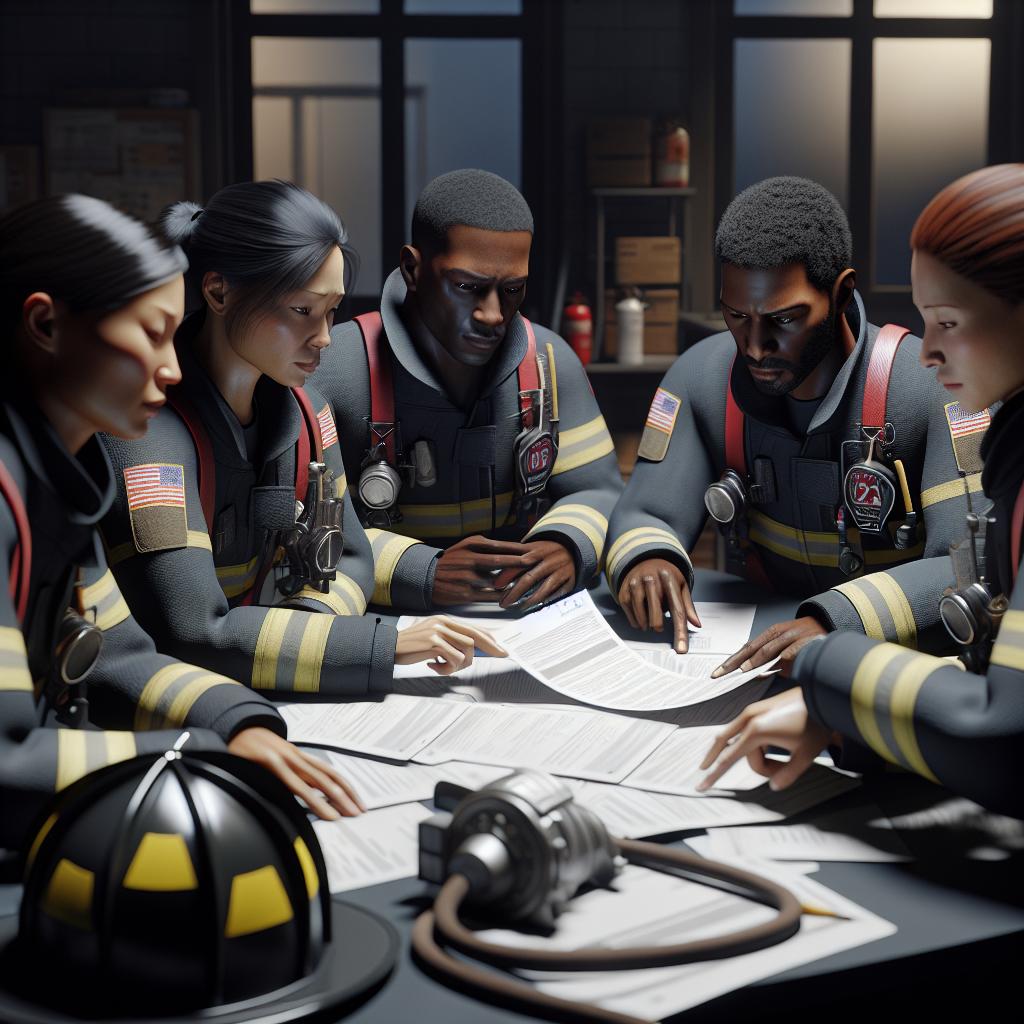Asheville Firefighters Advocate for Higher Pay Amidst Calls for Raises
‘We’re falling behind:’ Asheville firefighters push for higher pay
ASHEVILLE – Standing on a low, concrete wall at a lively May Day labor rights rally in Pack Square Plaza, Asheville Fire Capt. Welcker Taylor gave a variation on a speech he’s been practicing a lot lately. City firefighters are advocating for higher pay, echoing calls from a similar 2021 movement that eventually brought new Asheville firefighters from hourly rates of $11.65 to $15.
The annual starting salary for an Asheville firefighter, after graduation from the academy, is $46,256. For a typical 40-hour work week, that’s above the city’s living wage rate set by WNC Just Economics. But firefighters work 24-hour shifts in a 56-hour work week. That comes out to $15.88 an hour.
Are Raises Coming?
As the city plans to bring all other employees up to $19 an hour in its fiscal year 2025 budget, firefighters like Taylor fear they are being left behind. City Manager Debra Campbell will present her proposed budget May 14. Asheville City Council will vote to approve it in June. The goal, Taylor said, is to get AFD’s lowest paid workers back to competitive pay.
“We’ve fallen back into the same place we were before,” he said. “We are the asterisk any time (the city talks) about hourly pay and getting to a living wage.”
Miller said yearly pay for starting firefighters rises above the city’s minimum annual salary. Taylor argues that beyond the hourly compensation, and even annual pay, they aren’t competitive with other North Carolina departments. In a city with rents among the highest in the state, he said AFD salaries aren’t enough to keep people there. He and others say they are seeing higher turnover, less experienced crews and fewer trucks on the road.
“However you want to slice it, we’re falling behind,” he said.
What Raises are the City Considering?
Personnel, which includes compensation and benefits for the city’s 1,200 employees, is the largest budgetary expense in the general fund: a 62% slice of the multimillion-dollar pie. In an April 9 budget work session, staff recommended a 4.1% pay increase for all city employees, which will bring its workers up to the “pledged” living wage of $19 an hour, or a $39,520.
This proposal will not reach the city’s actual living wage of $22.10 an hour, calculated by Just Economics based on Fair Market Rents. Just Economics sets both the living wage rate and a “pledged” rate, which includes a commitment to raise wages 3% plus inflation until the living wage for that year is met.
The lowest paid city employee makes $37,960 annually. With slowing revenue growth and increasing costs, the city is facing mounting budgetary strains, said Finance Director Tony McDowell, who brought the staff recommendation to council April 9.
To fund the proposed increase, the city will have to dip into its fund balance contrary to city policy, which recommends the fund balance be limited to non-recurring expenditures. At council’s request, other compensation options were considered.
Vicki Meath, executive director of Just Economics, said while she appreciates the city considering the pledged rate as a benchmark, “I think there are more creative ways that the city can offer wage increases for cost of living that help us get closer to a living wage, if not to a full living wage.”
She hoped council would consider something in the middle: Not the priciest across the board dollar increase, or the lowest, but a $2,400 raise for everyone, plus support for the firefighter union’s request. Welcker said they were asking for AFD’s lowest paid hourly workers to be brought up to $18.25 an hour. When adjusting for compression in the surrounding pay steps, this would mean more than 100 firefighters were given raises over the 4.1% recommended by staff, he said.
It would bring every firefighter’s annual salary up to a minimum of $53,144.
‘Here we are again’
Mullins is now the state policy and legislation representative for the International Association of Firefighters in Washington. He is also president of the Professional Fire Fighters and Paramedics of North Carolina.
“Here we are again, in the same position as a couple years ago, with firefighters making below the living wage,” Mullins told the Citizen Times May 2. While he agreed AFD follows a similar pay model as fire departments in other cities, he said firefighter compensation is an issue across the state.
While Asheville “is better than other places” regarding pay, it’s still getting outpaced by nearby municipalities, like Charlotte, he said. It’s further complicated by the city’s high cost of living.
“Asheville’s firefighters are often taking jobs elsewhere,” he said. They’re even losing firefighters to nearby departments, like West Buncombe, with its starting salary of $53,980, which was unheard of a few years before.
Often in these conversations, city leadership will say it’s not “apples to apples” to compare firefighter compensation to other public employees. On this, Mullins disagrees.
“They need to be compensated for every hour they are away from their family,” he said. People often say those shifts include time spent sleeping, but a third of calls came at night, Taylor said. He’s still expected to work during all of those hours, he said, which annually totals 832 more than a typical 40-hour employee.
Charles Morales, another Asheville firefighter, said the model has been “normalized.”
“That’s a bigger conversation. Why can’t Asheville be the city that changes that idea? Let’s not normalize people getting paid this much, it doesn’t make any sense,” he said.
Both Morales and Taylor said they have to rely on overtime to make ends meet. Taylor said it’s not an effective long-term solution.
How has Council Responded?
During the year’s budget talks, council member Kim Roney has repeatedly brought up firefighter pay and her concerns that the difference in pay structure is inequitable. But conversation during an April 18 agenda briefing — a virtual meeting of the full council typically used to review the upcoming agenda and talk about big topics — reached no clear consensus on the way forward.
Of the firefighter’s proposal, Mayor Esther Manheimer said it would be difficult to approve raises above-and-beyond for AFD without looking across all departments.
“I get that we’ve been talking about how the firefighters have unique schedules, but then we’re not willing to look at a unique solution?” Roney said. “It seems like I’m missing something here. Wouldn’t we look at a unique solution for a unique schedule?”
Campbell said as the city considers compensation, it must consider all its employees.
“We always talk about equity. We want to make sure that everyone on our staff has the opportunity to be compensated equitably,” she said. “It is not something against the fire department or the police department, but we have to represent all skill sets.”
She added that there are other pay opportunities for public safety workers not available for other employees, like additional pay for associate’s, bachelor’s, and master’s degrees and additional certifications. The salaries listed on the city’s open data portal represent base pay, but not other benefits. Fire and police also receive on-call pay, according to an April 22 memo obtained by the Citizen Times.
Last year, City Council approved 5% raises across the board, with one exception: Asheville police got 6%. During the April 9 budget work session, Campbell said intentions were good, particularly as the city struggled to recruit new officers, but that the decision ultimately “created some morale issues amongst the employees in terms of that differential.”
“I’m getting a little bit baffled what the point is in having this contentious conversation when I feel like all of council wants to pay all of our employees better,” Manheimer said in the April 18 meeting. “Our biggest problem is not that we disagree about that, it’s that we don’t have the resources to do it. So we’ve got to figure that out.”
She urged council to look ahead to the next budget season, which will fall in a property tax revaluation year. Those newly assessed values will be used when the City Council considers its fiscal year 2026 budget, according to the memo. Budget staff projected as part of its five-year forecast that council will have to set a property tax rate above revenue neutral next year to fund both debt service on the proposed November 2024 bond referenda and ongoing needs in the general fund.
‘We Can’t Ignore the Numbers’
According to AFD information, which Miller relayed to the Citizen Times, the department has 294 total full and part-time positions. Of those, 288 are uniformed positions. Through information gathered in resignation exit interviews, the department said that employees leave for an “array” of reasons other than solely based on pay or going to another department, including personal or family reasons, such as having a child, moving closer to family, or changing careers. Resignations include both uniformed and non-uniformed.
Resignations:
– 2016: 12
– 2017: 7
– 2018: 5
– 2019: 4
– 2020: 9
– 2021: 9
– 2022: 12
– 2023: 17
– 2024: 3 *As of May 2
In an address to council April 23, Taylor said “dissatisfaction” is driving firefighters away. If nothing changes, he said, people will continue to leave, and more will be spent on overtime.






